YAMAHA VIKING 2014 Owners Manual
Manufacturer: YAMAHA, Model Year: 2014, Model line: VIKING, Model: YAMAHA VIKING 2014Pages: 180, PDF Size: 3.78 MB
Page 161 of 180
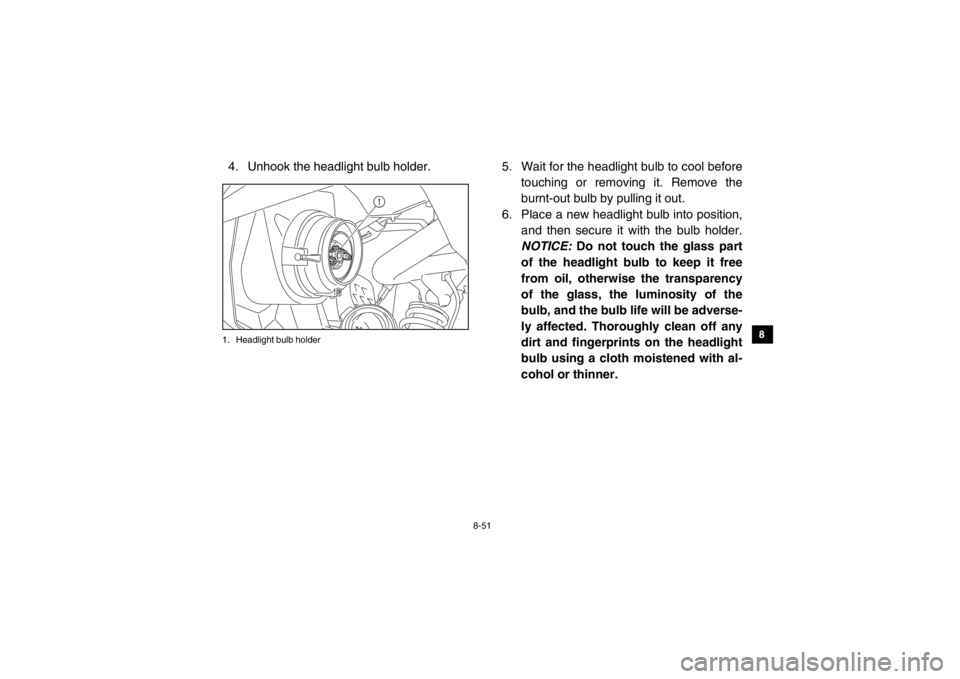
8-51
1
2
3
4
5
6
78
9
10
11
12
13
14
4. Unhook the headlight bulb holder.1. Headlight bulb holder
5. Wait for the headlight bulb to cool beforetouching or removing it. Remove the
burnt-out bulb by pulling it out.
6. Place a new headlight bulb into position, and then secure it with the bulb holder.
NOTICE: Do not touch the glass part
of the headlight bulb to keep it free
from oil, otherwise the transparency
of the glass, the luminosity of the
bulb, and the bulb life will be adverse-
ly affected. Thoroughly clean off any
dirt and fingerprints on the headlight
bulb using a cloth moistened with al-
cohol or thinner.
1
1XP7B_EE.book Page 51 Tuesday, February 4, 2014 3:40 PM
Page 162 of 180
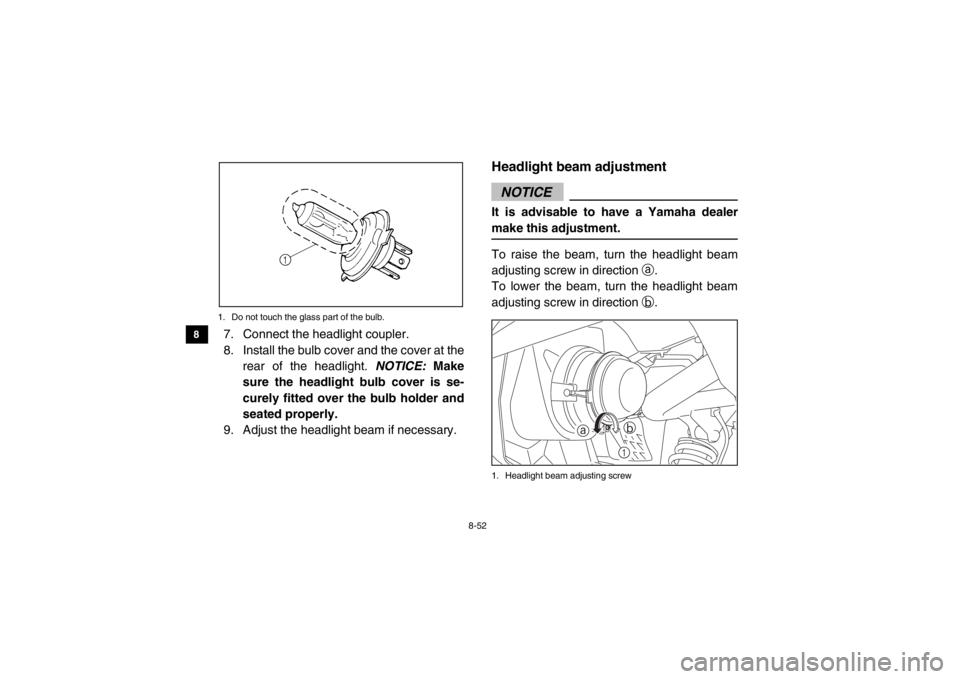
8-52
8
9
10
11
12
13
14
1. Do not touch the glass part of the bulb.7. Connect the headlight coupler.
8. Install the bulb cover and the cover at the rear of the headlight. NOTICE: Make
sure the headlight bulb cover is se-
curely fitted over the bulb holder and
seated properly.
9. Adjust the headlight beam if necessary.
EVU00990Headlight beam adjustmentNOTICEIt is advisable to have a Yamaha dealer
make this adjustment.To raise the beam, turn the headlight beam
adjusting screw in direction a.
To lower the beam, turn the headlight beam
adjusting screw in direction b.1. Headlight beam adjusting screw
1
a
b
1XP7B_EE.book Page 52 Tuesday, February 4, 2014 3:40 PM
Page 163 of 180
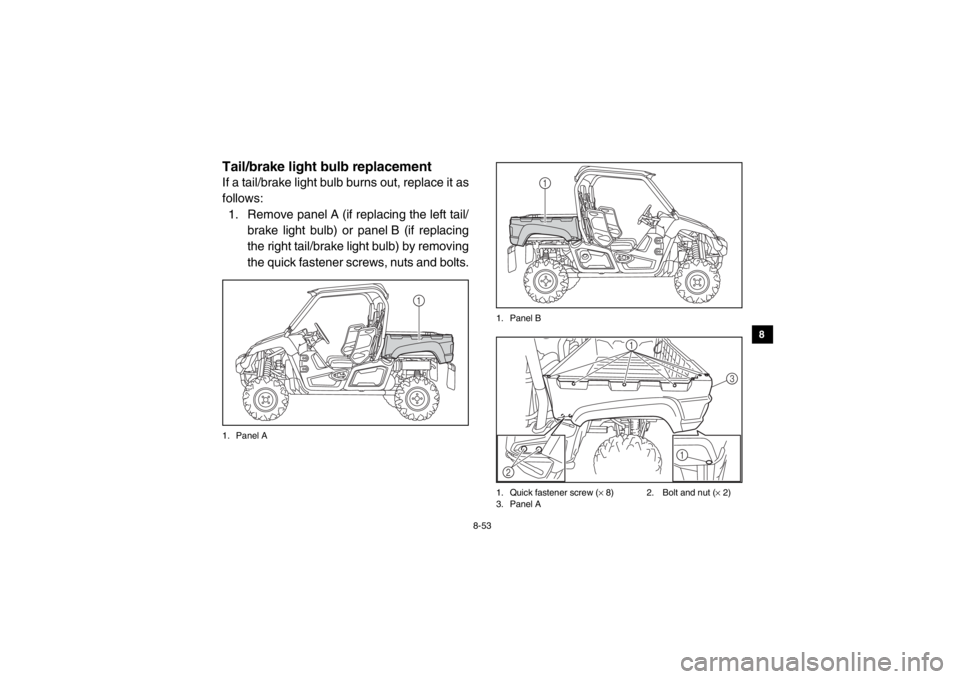
8-53
1
2
3
4
5
6
78
9
10
11
12
13
14
EVU01000Tail/brake light bulb replacementIf a tail/brake light bulb burns out, replace it as
follows:1. Remove panel A (if replacing the left tail/ brake light bulb) or panel B (if replacing
the right tail/brake light bulb) by removing
the quick fastener screws, nuts and bolts.1. Panel A 1. Panel B
1. Quick fastener screw (
× 8) 2. Bolt and nut ( × 2)
3. Panel A
1
1
1
3
2 1
1XP7B_EE.book Page 53 Tuesday, February 4, 2014 3:40 PM
Page 164 of 180
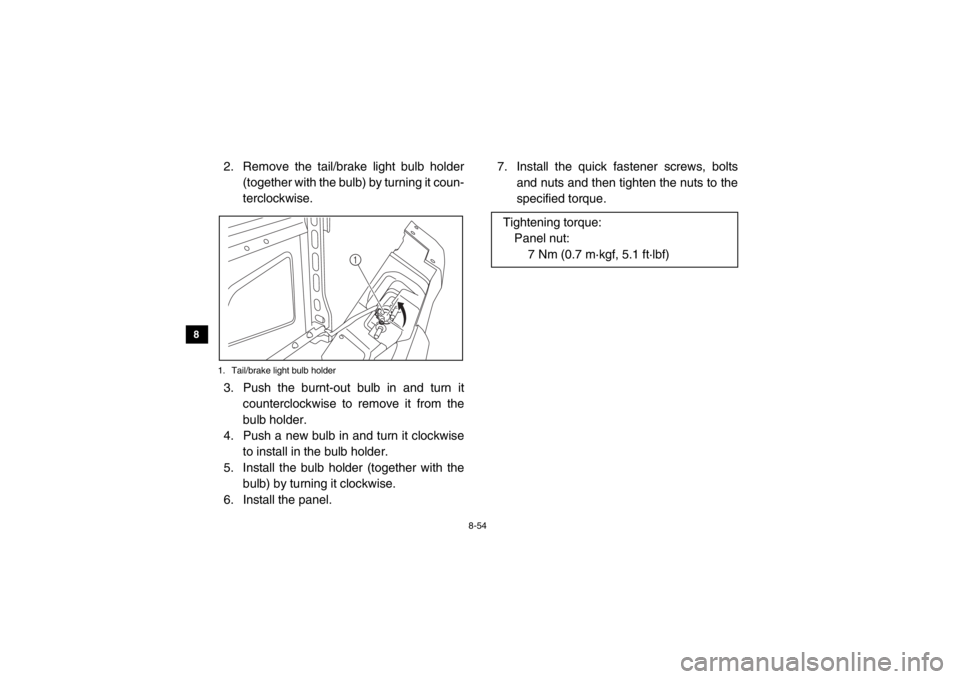
8-54
8
9
10
11
12
13
14
2. Remove the tail/brake light bulb holder (together with the bulb) by turning it coun-
terclockwise.1. Tail/brake light bulb holder3. Push the burnt-out bulb in and turn itcounterclockwise to remove it from the
bulb holder.
4. Push a new bulb in and turn it clockwise to install in the bulb holder.
5. Install the bulb holder (together with the bulb) by turning it clockwise.
6. Install the panel. 7. Install the quick fastener screws, bolts
and nuts and then tighten the nuts to the
specified torque.
1
Tightening torque:Panel nut: 7 Nm (0.7 m·kgf, 5.1 ft·lbf)
1XP7B_EE.book Page 54 Tuesday, February 4, 2014 3:40 PM
Page 165 of 180
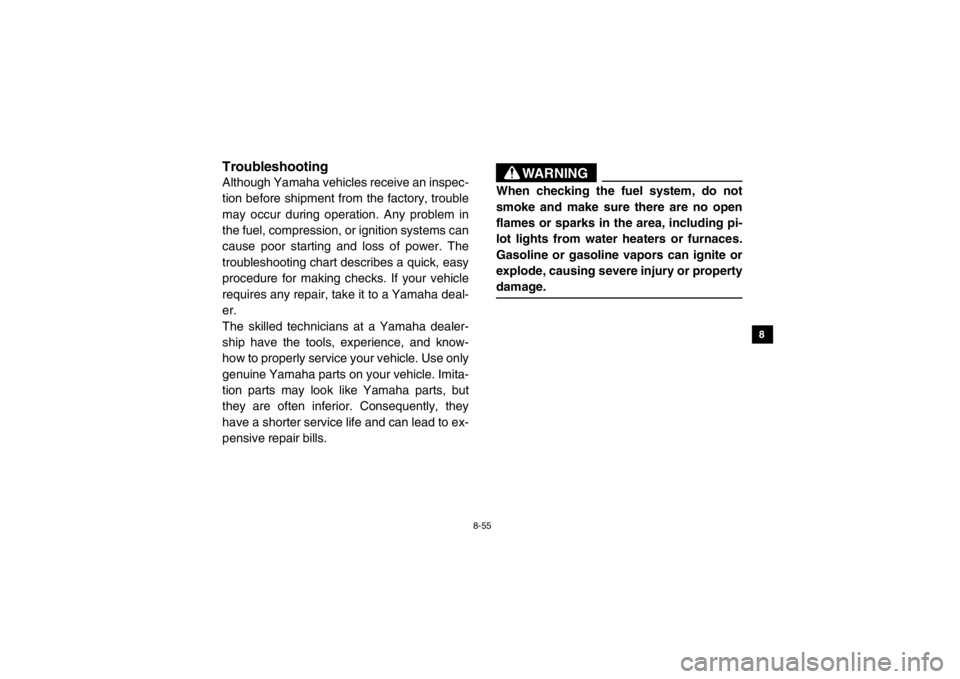
8-55
1
2
3
4
5
6
78
9
10
11
12
13
14
EVU01010TroubleshootingAlthough Yamaha vehicles receive an inspec-
tion before shipment from the factory, trouble
may occur during operation. Any problem in
the fuel, compression, or ignition systems can
cause poor starting and loss of power. The
troubleshooting chart describes a quick, easy
procedure for making checks. If your vehicle
requires any repair, take it to a Yamaha deal-
er.
The skilled technicians at a Yamaha dealer-
ship have the tools, experience, and know-
how to properly service your vehicle. Use only
genuine Yamaha parts on your vehicle. Imita-
tion parts may look like Yamaha parts, but
they are often inferior. Consequently, they
have a shorter service life and can lead to ex-
pensive repair bills.
WARNING
When checking the fuel system, do not
smoke and make sure there are no open
flames or sparks in the area, including pi-
lot lights from water heaters or furnaces.
Gasoline or gasoline vapors can ignite or
explode, causing severe injury or property
damage.
1XP7B_EE.book Page 55 Tuesday, February 4, 2014 3:40 PM
Page 166 of 180

8-56
8
9
10
11
12
13
14
5B410024Troubleshooting chartsStarting problems or poor engine performance
Check the fuel level in
the fuel tank.1. Fuel
There is enough fuel.
There is no fuel.
Check the battery.
Supply fuel.
The engine does not start.
Check the battery.
Operate the electric starter.4. Compression
There is compression.
There is no compression.
The engine does not start.
Have a Yamaha dealer check the vehicle.Have a Yamaha dealer check the vehicle.
Remove the spark plug
and check the electrodes.3. Ignition
Wipe off with a dry cloth and correct the
spark plug gap, or replace the spark plug. Have a Yamaha dealer check the vehicle.
The engine does not start.
Check the compression.
Operate the electric starter.2. Battery
The engine turns over
quickly.
The engine turns over
slowly.
The battery is good.
DryWet
Operate the electric starter.
Check the battery lead connections,
and have a Yamaha dealer charge
the battery if necessary.
The engine does not start.
Check the ignition.
1XP7B_EE.book Page 56 Tuesday, February 4, 2014 3:40 PM
Page 167 of 180
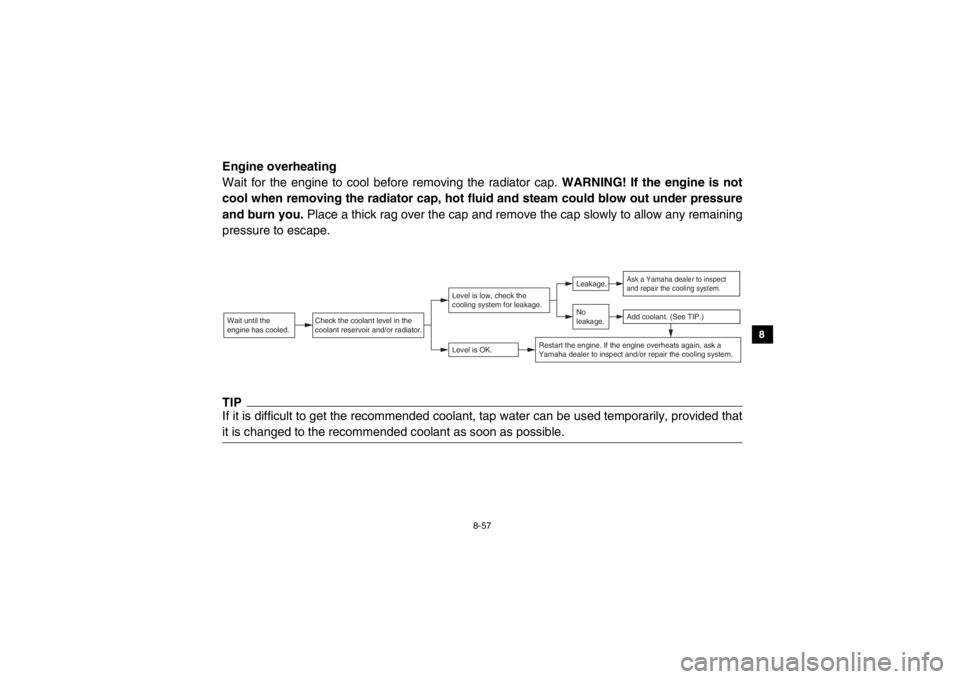
8-57
1
2
3
4
5
6
78
9
10
11
12
13
14
Engine overheating
Wait for the engine to cool before removing the radiator cap. WARNING! If the engine is not
cool when removing the radiator cap, hot fluid and steam could blow out under pressure
and burn you. Place a thick rag over the cap and remove the cap slowly to allow any remaining
pressure to escape.TIPIf it is difficult to get the recommended coolant, tap water can be used temporarily, provided that
it is changed to the recommended coolant as soon as possible.Wait until the
engine has cooled.
Check the coolant level in the
coolant reservoir and/or radiator.
Level is OK.Level is low, check the
cooling system for leakage.
No
leakage.Leakage.
Ask a Yamaha dealer to inspect
and repair the cooling system.Add coolant. (See TIP.)
Restart the engine. If the engine overheats again, ask a
Yamaha dealer to inspect and/or repair the cooling system.
1XP7B_EE.book Page 57 Tuesday, February 4, 2014 3:40 PM
Page 168 of 180

9-1
9
10
11
12
13
14
EVU01030
1-CLEANING AND STORAGE
CleaningFrequent, thorough cleaning of your vehicle
will not only enhance its appearance but will
improve its general performance and extend
the useful life of many components. 1. Before cleaning the vehicle:
a. Block off the end of the exhaust pipeto prevent water entry. A plastic bag
and strong rubber band may be used.
b. Make sure the spark plug and all filler caps are properly installed.
2. If the engine case is excessively greasy,
apply degreaser with a paint brush. Do
not apply degreaser to the wheel axles. 3. Rinse the dirt and degreaser off with a
garden hose. Use only enough pressure
to do the job. WARNING! Test the
brakes after washing. Apply the
brakes several times at slow speeds
to let friction dry out the linings. Wet
brakes may have reduced stopping
ability, increasing the chance of an ac-
cident. NOTICE: Excessive water
pressure may cause water seepage
and deterioration of wheel bearings,
brakes, transmission seals and elec-
trical devices. Many expensive repair
bills have resulted from improper
high-pressure detergent applications,
such as those available in coin-oper-
ated car washers.1XP7B_EE.book Page 1 Tuesday, February 4, 2014 3:40 PM
Page 169 of 180

9-2
1
2
3
4
5
6
7
89
10
11
12
13
14
4. Once the majority of the dirt has beenhosed off, wash all surfaces with warm
water and mild, detergent-type soap. An
old toothbrush or bottle brush is handy for
hard-to-get-at places.
5. Rinse the vehicle off immediately with
clean water and dry all surfaces with a
clean chamois towel or soft, absorbent
cloth.
6. Clean the seats with a vinyl upholstery cleaner to keep the covers pliable and
glossy.
7. Automotive-type wax may be applied to all painted and chrome-plated surfaces.
Avoid combination cleaner-waxes. Many
contain abrasives which may scratch the
paint or protective finish. When finished,
start the engine and let it idle for several
minutes.
5B410025StorageLong term storage (60 days or more) of your
vehicle will require some preventive proce-
dures to guard against deterioration. Make
any necessary repairs before storing the vehi-
cle.
After thoroughly cleaning the vehicle, prepare
for storage as follows:1. Fill the fuel tank with fresh fuel and add
the specified amount of Yamaha Fuel
Stabilizer and Conditioner or equivalent
product. Operate the vehicle for at least
5 minutes to distribute treated fuel
through the fuel system.
Specified amount: 1 oz of stabilizer to each gallon of fuel (or
7.5 ml of stabilizer to each liter of fuel)
1XP7B_EE.book Page 2 Tuesday, February 4, 2014 3:40 PM
Page 170 of 180

9-3
9
10
11
12
13
14
2. Remove the spark plug, pour about one tablespoon of SAE 10W-40 or 20W-50
motor oil in the spark plug hole and install
the spark plug. Ground the spark plug
wire and turn the engine over several
times to coat the cylinder wall with oil.
3. Lubricate all control cables.
4. Block up the frame to raise all wheels off the ground.
5. Tie a plastic bag over the exhaust pipe outlet to prevent moisture from entering.
6. If storing in a humid or salt-air atmo-
sphere, coat all exposed metal surfaces
with a light film of oil. Do not apply oil to
any rubber parts or the seat covers. 7. Remove the battery and charge it. Store
it in a dry place and recharge it once a
month. Do not store the battery in an ex-
cessively warm or cold place [less than
0 °C (30 °F) or more than 30 °C (90 °F)].
Use of fuel stabilizer and conditioner elimi-
nates the need to drain the fuel system. Con-
sult a Yamaha dealer if the fuel system needs
to be drained.1XP7B_EE.book Page 3 Tuesday, February 4, 2014 3:40 PM